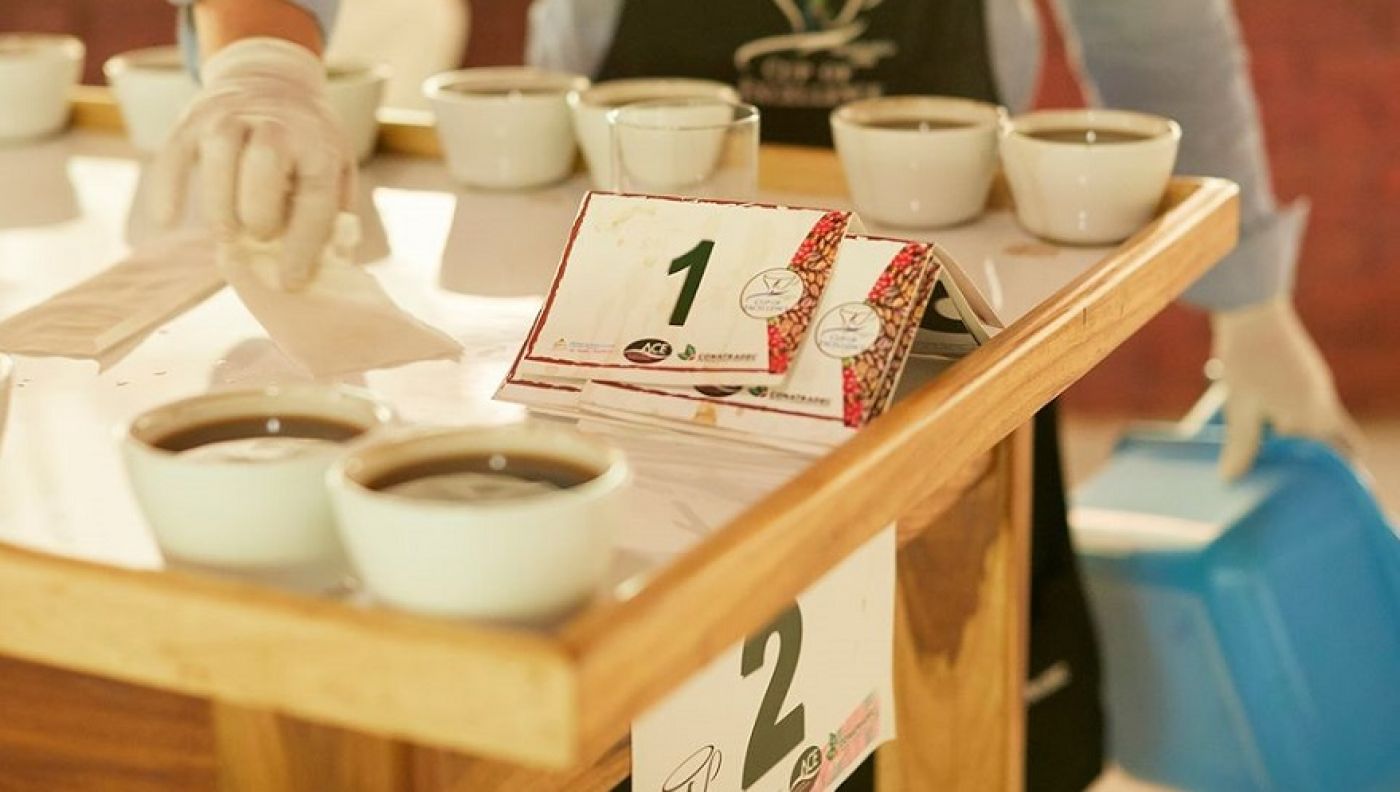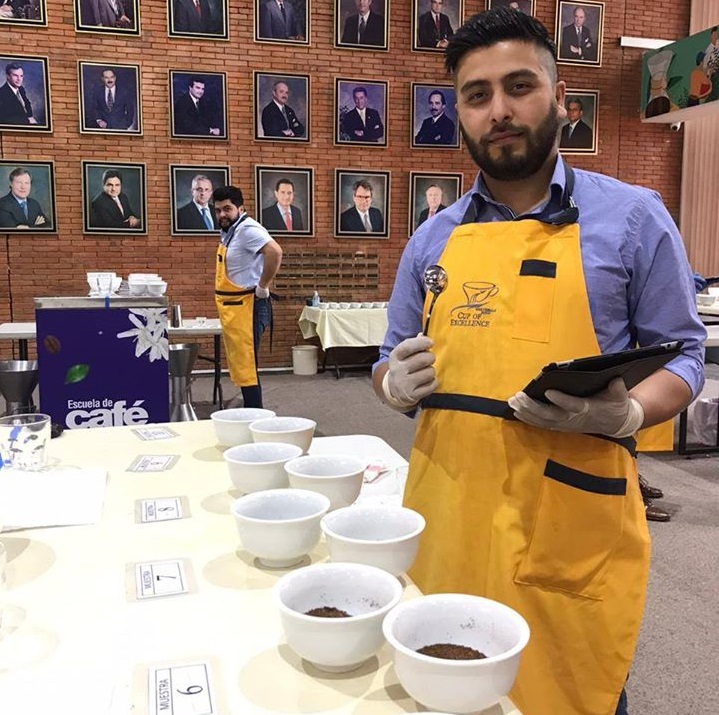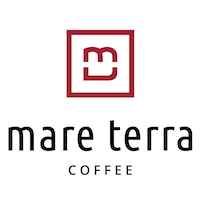
COE Scoring Protocol
The protocol used for the Cup of Excellence competition is the strictest protocol of all known. The main objective of this protocol is to find the coffees that, due to their cleanliness, sweetness, stability and their unique profiles, best represent the current harvest of each country.
The maximum score of this protocol is 100 points, where the coffees that have obtained more than 85 points are the winning lots of the National Contest (National Winners) and the coffees that have obtained a score greater than 87 are the winning lots of the International Contest In addition, those who score higher than 90+ receive an Organization President's Award.
All the winning lots of the International Contest (Cup of Excellence) are those that participate in the online auction that is carried out by country.
COE judge evaluating coffee
How do we prepare for the valuation?
The conditions and regulations for tasting preparation are very similar to those for SCA, but the evaluation protocol contains differences. Normally, the Cup of Excellence protocol evaluates 8 samples in each tasting session, except in the last session of the championship, where the 10 best coffees are evaluated. A maximum of 4 people can work at each table.
The total time to complete the protocol is 45 minutes from when the water begins to be poured until the information required by it is completed. During this period of time, the taster must evaluate how the characteristics of the coffee evolve in three temperatures: hot, warm and room temperature.
- Material: We will need 4 cups per sample (the volume of each has to be from 200 to 260 ml) spoons, glasses with water, glasses to clean the spoons, glasses to spit, napkins, codes with which we will have marked each of the samples and a stopwatch.
- Coffee: We will prepare a medium-light roast (60-65 for Agtron or Probat 90-105 -Colorette).
- Water: Temperature +/- 93, ppm-75-250 and ph-6.5.
Steps for preparation:
- We weigh the coffee, it depends on the volume of the cup - 5.5-6 (+/- 0.1) grams of coffee for every 100ml of water.
- Let's grind the coffee from each cup separately. Purging the mill between sample and sample with the use of a small amount of the same coffee, the grinding point is half coarse (70% of sample - 850mµ)
- We prepare the table by placing a glass of hot water and a napkin near each sample
- We provide each cup taster with a container to spit and the COE scoring form
- Once we have prepared the table with ground coffee we no longer touch the cups
Assessment steps:
- We analyze the intensity of roasting: we note if any sample has a darker or lighter color than other samples.
- We analyze the fragrance (the dry aroma): we note the intensity, quality and the descriptors.
- We pour the water, with the same speed and height, as evenly as possible. We wait 4 minutes.
- We analyze the scrab aroma, without touching it, we value intensity and quality, we write down the descriptors.
- With the spoon, we "break" the crust, touching only the surface, without going down to the bottom of the cup as evenly as possible. Between cups and cups we pass the spoon through the nearest glass of hot water, so as not to contaminate possible defects between cups. We analyze the aroma, we value the intensity and quality, we write down the descriptors.
- When the aroma is analyzed, we clean the surface with 2 spoons.
- We can start cupping between 10 and 12 minutes from the start of the infusion, when the temperature reaches about 60 degrees.
- We do a first round of calibration, we test all the cups on the table without evaluating, but pointing out if there are any doubts about the uniformity or cleanliness of some cups, it is also a good time to point out some descriptors that draw more attention.
- With the second pass, the temperature of the coffee will be close to 50 degrees, we can write down the descriptors of the coffee. We began to assess the characteristics, marking the scales but not yet putting the scores. If we clearly see the presence of any possible defect, we must note the intensity and type of the defect. Once noted and we stop evaluating this sample. A coffee that has a ferment, finol, fungus or chemical stain will be disqualified.
- With the third pass (the temperature is already close to 40 degrees) we have to see how the characteristics of the coffee evolve. With arrows we indicate if the score increases or decreases.
- With the fourth pass (the temperature is close to 30 degrees) it is necessary to finish with the evaluation, the description and put the scores of all the attributes

How is the valuation carried out?
- The aroma is evaluated 3 times: dry, the crust and at the moment of breaking the crust. We have to record intensity and quality, using a 3-point scale, where 1 means low quality / intensity, 2 points - medium quality / intensity and 3 is very high quality / intensity. This score is informative and helps describe the sensory profile, but does not add up to the overall score.
- We evaluated 8 attributes, including Cleanliness, Sweetness, Acidity, Body, Taste, Aftertaste, Balance and General that are valued with a scale with a maximum of 8 points. From 0 to 6 on a 1-point scale, from 6 to 8 on a scale of 0.5.
- The Acidity and Body Attributes, apart from a quality scale, have an intensity scale, with three levels: little, medium, high.
- Tasting with this protocol it is very important to write down all the descriptors that we find evaluating all attributes of each sample, not to forget to point out types of acidity, tactile sensations in the mouth.
How are defects evaluated?
A defect is a problem in the cup that can be caused by phenol, ferment, fungus, chemical stains or other types of stains that we can clearly name and that decrease both the quality and the cleanliness of the cup. By this protocol the defect can have 3 levels of intensity: low, medium and high.
Defect intensities:
The intensity of the defect found is multiplied by the cups that contain it and then by 4, the result is subtracted from the final score. For example, if in a sample we find 1 cup with a low intensity defect. 1X1X 4 = 4 points, in this case we have to subtract 4 points.
How is final score calculated?
There are 8 attributes that are rated on a scale of a maximum of 8 points. The results of evaluating these attributes are added and a coefficient of 36 added and subtracting defect points. For example, a sample in all its attributes valued at 7 points, and it does not have any defect is 7 + 7 + 7 + 7 + 7 + 7 + 7 + 7 + 36 - 0 = 92 points, a lot of this quality without a doubt going to enter the TOP10 or probably going to win the competition.


